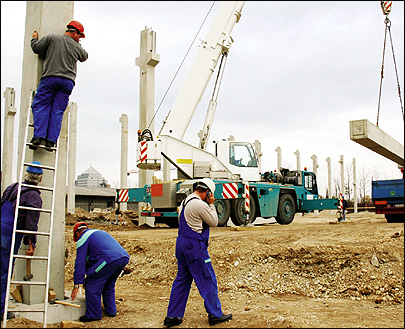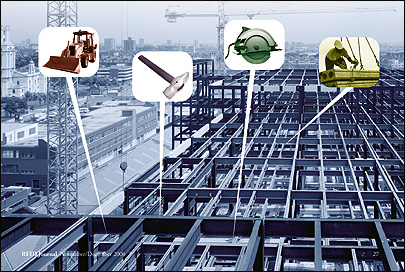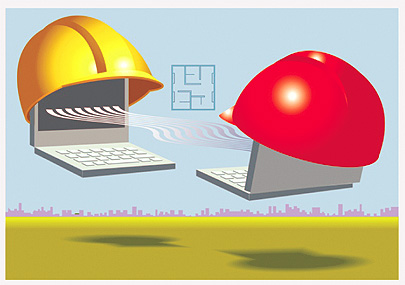Dec 01, 2006While the construction industry is busy erecting awe-inspiring modern skyscrapers, museums, bridges and manufacturing facilities, the sector has not kept up with other industries, such as manufacturing and aerospace, that have used information technology to increase productivity over the past 30 years, according to research studies. Cost overruns, safety troubles, delays and quality issues continue to curse the sector—just look at the $1.4 billion in cost overruns at Boston's Big Dig site or the $3 billion overrun and 16-month delay in constructing Denver's International Airport.
A construction project—whether it's an office building, factory, bridge, airport or other facility—is a highly coordinated, complex operation that must run according to schedule. Easier said than done. To maintain the schedule, the right supplies, tools, equipment and workers need to be in the right place at the right time. But supplies aren't always delivered in the right order so they can be installed in the proper sequence, and construction sites are often vast locations where supplies, tools and other equipment can be misplaced or stolen. Any delay in a construction schedule can be costly to the contractor in terms of salaries, leased equipment and maintaining security at a job site for longer than was budgeted. Delays also impact clients by denying them immediate use of a building, tunnel or plant.
Some in the construction industry believe RFID can help track the shipping and receipt of supplies, to realize significant efficiency gains. RFID is being tested on construction sites from Texas to London to track tools—from hammers and screwdrivers to the more expensive jackhammers and welding supplies—to reduce loss and theft. Heavy equipment providers that lease cranes, bulldozers and other machinery are testing or deploying RFID to keep track of assets and monitor their use, to maximize lease revenues and prevent equipment from sitting unused on a construction site for lengthy stretches. In addition, companies are testing RFID to keep tabs on workers, ensuring both their safety and productivity.
To spur further testing and deployment of RFID in the United Kingdom, in July the RFID Centre formed a strategic partnership with the Construction Industry Computing Association, an organization that promotes the use of information technology in the construction industry. The groups have been holding seminars to help educate and advise companies about RFID and other wireless technologies and their potential uses in construction.
In the United States, the move to understand how RFID technology can make construction sites more productive and safer got started a few years ago. In 2003, FIATECH (Fully Integrated and Automated Technology)—a group of construction-industry leaders who have organized to accelerate the implementation of technologies that improve their bottom line—undertook a series of RFID pilots. The results of the pilots—which included some of the biggest U.S. construction firms, such as Bechtel, Fluor, KBR (Halliburton) and Zachry Construction Co.—were promising.
"People in the construction industry see EZ Passes in use where you don't even pause when going past a reader. And they say, 'We can do this with cars and overnight packages, why aren't we doing it with construction?'" says Richard Jackson, director of FIATECH. "They ask whether they should use these things when they can cost thousands or tens of thousands. My answer is, 'Absolutely.' Don't even think about it if it costs $25,000. You can realize millions of dollars in savings when you save days on the schedule."
One of the most promising uses for RFID would be to help in construction-site management. "You can lay down an area of 80 acres in a big construction project and engineers and managers have a big challenge in knowing whether stuff is there or not," says Barry Allen, vice president of technology for Identec Solutions, an RFID solutions provider. "You can be at a critical stage in a construction project, and you need to find a piece of equipment that has to go in right now or else you have to stop the project and wait. It can be tremendously costly. Some of these projects have $100,000 a day in liquidated damages if you don't deliver on time."
In 2004, Fluor participated in a FIATECH pilot to automate the tracking of fabricated pipe in a construction supply chain involving the building of an oil refinery. Typically, each piece of pipe is identified by a metal hang tag with the project name, where the piece goes, and specifications about the materials and paint used in making the pipe. When a truckload of pipe arrives at a construction site, the metal tags are hand-inspected and the information recorded to make sure that all the necessary pieces have arrived. Fluor officials say the process is time-consuming and prone to errors.

In the RFID pilot, each piece of piping was fitted with an active RFID tag that included the unique information for that part. The pipes were loaded onto flatbed trailer trucks and the tags were read as they passed RFID interrogators at the entrance gates to the construction site. The tags on hundreds of pieces of pipe were read at one time and recorded in an electronic database. RFID reduced inaccuracies and radically reduced the amount of time it took to verify, document and record the information on each piece of pipe.
"Think about a flatbed truck that is transporting 300 pieces of pipe—if they forgot one, you have a big problem," says Allen of Identec, which supplied the technology for the pilot. "If it's tagged and there is a gate reader at the construction site, we know it just arrived on site and know approximately where it is and that every piece of pipe is there."
Fluor officials say that they have not yet implemented RFID for fabricated pipe tracking, but they believe that the technology will be adopted in the near future, once the cost of tags drops (they were in the $40 to $50 range per tag in the pilot) and software standards are adopted in the construction supply chain.
Other obstacles need to be overcome. In the construction industry, many materials are made of metal, a substance that can interfere with RF readings. Tests have shown that the positioning of tags and interrogators and the use of active tags, which have longer read ranges, can surmount this problem. A more difficult problem may be that RFID tags on supplies at construction sites could be damaged when exposed to harsh environments and rough handling. Tag manufacturers need to take this into account when designing tags for the industry, FIATECH recommends.
But ultimately, FIATECH officials believe that RFID can help construction projects move closer to a just-in-time delivery on the job site. Through better accounting of receipt and inventory, RFID could help companies increase efficiency in their scheduling by 10 percent by not wasting time waiting for materials to arrive. Because some major construction projects take up to two or three years to complete, FIATECH estimates a 10 percent savings in schedule time could amount to millions of dollars.
The Construction Industry Crime Prevention Program, a nonprofit organization formed to fight construction site vandalism and theft in the United States, estimates that losses from the theft and vandalism of tools and equipment amount to more than $26 million annually in the Pacific Northwest alone. The National Association of Home Builders reports that losses from residential construction job sites account for 1 percent to 2 percent of the average cost of building a new home. The group estimates that construction site thefts in the United States exceed $1 billion each year. In addition, the theft of heavy construction equipment, such as pavers and tractors, from poorly protected job sites is predicted to cost U.S. manufacturers, owners and insurers more than $1 billion annually, according to assessments from the Insurance Services Office, which supplies data and analytics to many fields to help professionals evaluate risks and detect fraud.
Losses aren't limited to the United States, either. Research by Jimmie Hinze, a University of Florida professor in the College of Design, Construction and Planning, found that more than 1,000 construction machines were stolen in Japan in 2001, and that annual insurance claims from construction theft in Canada exceed $46 million yearly.

Because of this, RFID is being tested and deployed to fight loss and theft and help locate tools on the construction job site. For example, at the construction site of Heathrow Airport's $8 billion Terminal 5 project in London, AMEC, an international engineering and services company, has been using RFID to manage and track tools used in its multi-million-dollar mechanical and electrical services contract, according to Frank Stokes, an AMEC spokesperson. The company has deployed the Tooltagz RFID system developed by Ascendant Technologies, which reads tags on tools with the use of handheld interrogators. The information is collected and entered into a central database that contains data on types of tools, location and maintenance history. RFID is helping the company eliminate loss and/or theft and, at the same time, to better manage the location of tools being used on the massive airport project to avoid delays.
Last year, Zachry Construction participated in a two-step pilot with FIATECH to determine whether RFID was feasible for tracking tagged tools taken from a tool room with an RFID portal equipped with interrogators at the doorway or from a large toolbox known as a Gang box also fitted with RFID interrogators. Currently, the firm tracks tools with bar-code technology: Construction workers go to a counter and ask for tools; when the tools are located, the bar codes are scanned with a handheld reader along with the employee's ID badge.
The first stage of the Zachry pilot was a two-day test in a controlled environment in the company's home office in San Antonio, Texas. The second stage, which lasted 45 days, involved deploying the technology in the field, on a power-plant maintenance project. The tools tagged with active RFID tags included band saws, oxygen gauges for welding equipment and pneumatic impact wrenches. "One of the things we were looking at was to compare the two technologies, RFID and bar code, in the check-in and checkout of tools," says Todd Sutton, Zachry's business unit manager, who oversaw the pilot. The pilot found that the average scan time for tools with RFID tags was 1.66 seconds per tool compared with 4.92 seconds for bar-coded tools. At the same time, the pilot found that bar codes provided slightly more accurate reads, although Sutton says the middleware used in the pilot was partly to blame.
While tool tracking on the job site is promising, some companies are already tracking larger, more expensive assets. Since October 2005, Al Jaber, a United Arab Emirates construction company, has been placing active RFID tags on its fleet of 20,000 construction vehicles and trailers. The company has tagged 7,000 vehicles, according to Tapan Desai, of Amtel Security Systems, a Miami-based company specializing in access control and security systems, which is working with Al Jaber. "There is a lot of equipment given to other firms without the company knowing about it," says Desai. "The drivers are making extra money doing this." The goal of the tagging is to help the company ensure that its vehicles are reliably checked in and out of their storage facilities.
Keeping Workers Safe and Productive
Construction can also be a highly hazardous occupation. Between 1980 and 1995, at least 17,000 construction workers in the United States died from injuries suffered on the job, according to the National Institute for Occupational Safety and Health. The construction industry lost more workers to traumatic injury death during that time period than any other major industrial sector, NIOSH reported.
Keeping track of the location of workers has increasingly become a priority, particularly when construction work is in rugged terrain. VSH Hagerbach, a Swiss testing and research and development firm primarily serving the construction industry, announced in September that it is partnering with Wtek, a Norwegian company that deploys RFID to track workers in tunnels, mines and offshore drilling environments. Wtek's RFID system will be deployed within VSH Hagerbach's network for 5 kilometers of underground tunnels in its Sagrans facility. Data from the Wtek RFID system of tags and interrogators is fed into a central database called Watcher, which provides information on each tagged worker's location underground and can send maps to managers showing the last location in which each worker has been sensed.
In addition to safety, RFID is seen as a way to keep tabs on workers in large construction projects to ensure that the right number is reporting for work and the project is being kept on budget. "Normally, people have to clock in and clock out," says Callum Moy, of Advanced Positioning Systems, a London-based firm working with construction clients to track employees. "This is a way to check your budget in real time to figure out why you spend 3,000 hours in a location when the budget said you were supposed to spend 2,500 hours. Construction is all about managing a budget."
Recently, during the British Airport Authority's construction project of Terminal 5 at Heathrow, a two-day pilot was conducted to keep tabs on the number of workers entering and leaving a construction site. The pilot didn't track workers by name or even where they went or what they did at the construction project. "We didn't use it in the end," says BAA's Ian Hinckley, who oversaw the pilot. "We probably left it too late in the project cycle by the time we completed the test to consider whether it was really going to be a good enough demonstration to roll out a fairly expensive solution."
The idea that tracking construction materials—and even people—can reduce the risks of projects being delivered late and over budget is appealing to construction firms on both sides of the Atlantic. BT Auto-ID Services announced in October it has launched BT Constructnet, a real-time tracking solution designed to help contractors improve supply-chain efficiency by tracking supplies from manufacture through logistics to construction sites.
"Our industry is often slow to adopt new technologies," says John McQuarry, Fluor's vice president of technology strategy. "We do see our interest growing in the future…certainly in the tracking of equipment and materials from the fabricator all the way to the job site and ultimately into erection at the job site. There's even the potential for tracking maintenance-type information throughout the life cycle of a part." McQuarry says that some parts, such as a turbine or other equipment, might be installed in future projects with an active tag and sensors that can be used to read maintenance information and help determine when a part needs replacement.
The technology also could be used to help create physical repositories of data about structures. That type of access to information can not only help in the maintenance of a structure and its components, but it can come in handy for first responders to the scene of an emergency, such as a fire or earthquake—or even a potential terrorist attack.
"I have a dream," says FIATECH's Jackson, "that one day people could walk into an office like Captain Kirk on the deck of the Enterprise and say, 'Bring up the facility in Abu Dhabi and show me a hologram on my desk of the current situation I have with building No. 7 so that I can see if the beams were installed the right way.' It's not far from being a reality if we can get over the cost issues."
Communication Gap
One of the key issues standing in the way of widespread RFID adoption by the construction industry is that the myriad software programs used by the different firms involved in a project are not compatible, which makes it difficult to share the information gathered from tracking supplies and equipment. The problem is more acute in construction than in some other industries because of the sector's fragmented nature. Projects are conceived by architecture and engineering firms, built by construction companies with the help of assorted suppliers and contractors, and then handed over to project owners.
A U.S. government report in 2004 found that IT interoperability problems in the construction industry cost $15.8 billion per year in waste. The report, by the National Institute of Standards and Technology, a non-regulatory government agency, concluded that the problems stem from the highly fragmented nature of the industry, reliance on paper-based business practices and a lack of standardization on technology adoption.
"The only issues that yet remain are the software issues," says Richard Jackson, director of FIATECH, a group of construction-industry leaders who have organized to accelerate the implementation of technologies that improve their bottom line. "I've got this reader out there and I can read the information, but then how do I connect the information I just read into the software I'm using out on the site?"
FIATECH is conducting several projects and field tests to light a fire under those developing interoperability standards in the construction industry. That process has included reviewing the last 30 years of interoperability standards development in this and other industries, learning from past mistakes and successes, coupling that with new Internet-based techniques and developing ways to accelerate the deployment of standards. Jackson says that RFID could be an important component in helping the construction sector leapfrog over decades of other less-efficient technologies, similar to how developing nations encouraged the adoption of cell phone technology instead of building the physical infrastructure for landline telephones.
"I think it's going to have a huge impact," says Jackson. "One of the great interests in the construction industry right now is streamlining access to information. Every construction-industry association and every trade group talks about monitoring information throughout a life cycle of a construction project, from building it to tearing it apart."


